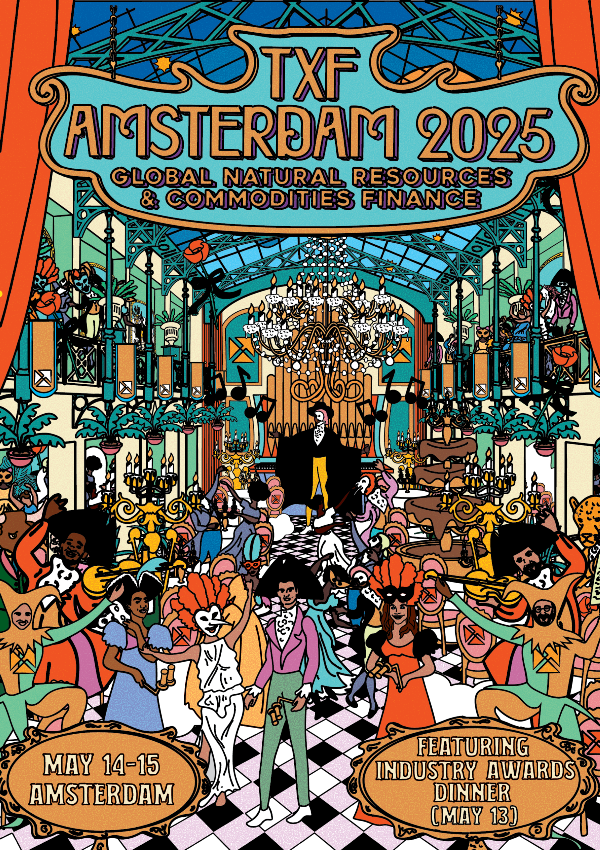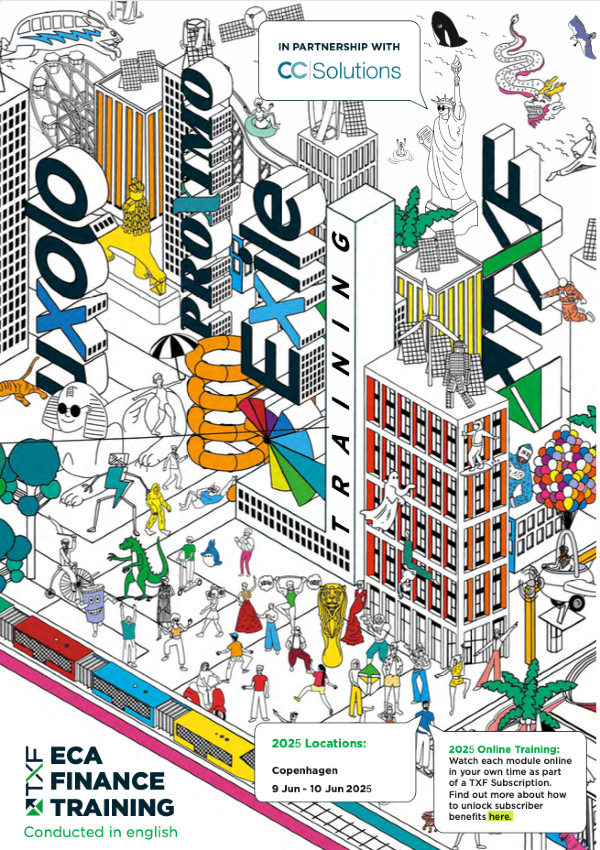Looking behind the mask on trade finance at ITFA
Katharine Morton ponders the opacities of financing trade, and what lies beneath, revealed at ITFA’s celebration of a mysterious dance of hide and seek

Hiding who you are is one of the key motives behind the tradition of the masquerade ball. It’s a playful custom that goes back to fifteenth century Venice, with identities usually revealed only after midnight. It wasn’t quite like that for the masked ball at this year’s International Trade and Forfaiting Association (ITFA) gala dinner in Budapest in early September, the organisation’s 46th annual event. The masks didn’t last long for most, and some still wore their delegate badges, so concealing identities was never going to be that easy.
Privacy, anonymity and being judged superficially on appearances rather than what’s actually underneath. Does that ring any bells for financing trade? Perhaps in the past, but the drive for transparency, visibility and control is behind all efforts to digitise both payments, and ultimately, trade. Trust in a trust-less world is hard to achieve though. What’s behind the mask of digitisation and trade was something explored in various forms throughout the event, which was also a celebration of 20 years of the (currently 210-member institution) industry association’s existence.
Tantalising possibilities of what lies beneath
The dance of digitisation of trade continues slowly, more a waltz (with steps both forward and backward) than a foxtrot. ITFA is playing a role in the development of the UTN (Universal Trade Network) which is a not-for-profit body being set up to standardise some of the digital rails for trade, and also the TFD Initiative on trade finance distribution to non-bank investors.
Sean Edwards, chair of ITFA and special adviser, trade finance, at SMBC says that digital negotiable instruments could soon be a possibility. He notes forfaiting [the F in ITFA, though one could be forgiven for thinking that the F now stood for Fintech, given the large number of tech players on show at the event] where negotiable instruments are the basic tool, has fallen out of fashion as they are too paper based and cumbersome to use.
However, digitisation possibilities raised in the pre-conference Fintech event, such as the announcement of a proof of concept between ITFA and a new player, EngioTime, which is promoting what it calls digital original documents (including bills of exchange and promissory notes), are among the opportunities Edwards highlights. “I like to think of digital promissory notes as trade finance mini bonds,” he enthuses – as attracting ISIN numbers, ratings, KYC information, all the trappings of tradeable instruments, beckon. Legal hurdles do remain, however, according to others at the event.
Hidden protectionism
Andreas Rees, chief economist of UniCredit Bank also looks behind the mask, but his is a pessimistic view of world trade, unpicking US President Donald Trump’s well-known assertion that trade wars are “good and easy to win.” Rees counters, “trade wars are easy to lose,” and have adversely effected both the US and China. A major issue is that a lot of trade is involved in global supply/value chains. Between 40-60% of all exports are part of global supply chains, he says. For instance, as much as 60% of German exports are not sold as final goods to one country and are intermediate goods which are processed and shipped again. Hiking tariffs have negative effects on global supply chains and distorting effects on prices. Similarly, in China, as much a half of the value added to Chinese industrial goods does not happen in the country. Simplistic views do have complex consequences for the global economy.
Hidden protectionism is in evidence in the broad span of trade barriers that have been implemented globally, not just the US and China. Rees points to the Global Trade Alert which highlights opaque barriers such as export subsidies, licensing, regulation, safety, tax-based incentives, local sourcing, etc. Since 2008, 600 of these have happened in the US (by number, not an impact analysis, because nearly two-thirds of these came under President Obama, not just Trump), nearly 250 were in the UK and 400 in India. China has implemented only about 170. Other hidden protectionism weapons come in the form of currency strength – or weakness. Rees gives no positive spin on the global economy (he is an economist after all).
It wasn’t all doom elsewhere in the event. Daniel Schmand, global head of trade at Deutsche Bank, agrees that trade wars are bad for trade, but asserts there are opportunities in uncertainty as it is good for trade finance, as long as banks can efficiently manage their own book. And this was a trade finance event, after all.
Surath Sengupta, global head of trade distribution at HSBC also sees opportunities amid the doom and gloom as the “where, what and how” of trade finance is shifting. ‘Where’ is that flows are changing, but trade is not stopping. The ‘what’ is changing – from financing physical goods to the rising importance of funding processes such as coding. The ‘how’ is how to maximise [bank] capital in using balance sheets and ensuring that enough liquidity is available for trade finance in terms of secondary participation. “You can’t keep book-and-hold and then try to sell between fellow banks who all have the same problem,” Sengupta says.
Schmand sees great opportunity in what he describes as the “next new mega trend” of the changing models of sell and buy to pay-as-you-go and pay-as-you-use, which raises the need for inventory finance [regulated under the changed accounting standards IFRS 9 and IFRS 16] in order to get off balance sheet finance. For instance, the market is moving from buying cars to paying as you use/rent, which has implications for financing micro-receivables. He also sheds light on moves to “tokenise single invoices” and repackage them to address the needs of different investors. It is important to make things easier for investors to buy what they need. “Standardisation may be helpful, but investors want to buy what they need,” he says.
Elephants trampling grass
Minos Gerakaris, head of trade at Rand Merchant Bank broadens the discussion on trade wars, most importantly today between the US and China. These are just the biggest two elephants in the room, but there are lots of smaller elephants which represent a significant portion of world trade. Gerakaris’ point is illustrated with an African proverb – “When two elephants are fighting, it’s the grass that gets trampled.” That grass includes emerging markets.
Those trade wars may also mean trade finance wars. Gerakaris notes that in South Africa, in times of stress, clients are moving back towards more traditional instruments, and while clients are using supply chain finance (SCF) for domestic trade, LCs predominate for cross-border trade.
Trade wars are manifested in trade finance wars too. For banks in emerging markets, there is a problem of return on assets being so thin and banks find themselves competing with export credit agencies (ECAs) who can wrap their lending. One audience member asserts, “Basel III is profoundly damaging to emerging market trade in particular,” especially given the fact that many deals have to be done in dollars, and the accounting treatment makes costs prohibitive.
For some, flattened grass can be equated with levelled playing fields. That may be an apt description of the regulatory fallout from Basel III/IV standards, in particular on capital adequacy, where treatment of ECAs is more benign in terms of their leverage ratios under the revised Capital Requirements Regulation (CRR2). Deutsche’s Schmand asserts trade finance has not been that proactive in its advocacy work to convince regulators of the importance of trade finance itself. While CRR2 does better reflect the nature of trade finance, “pockets of [the market] do better, but if [regulators have] made ECA financing so beneficial for banks, why can’t they do same for ESG /green financing, society goods, for instance,” he asks.
Paul Coles, head of global transactional distribution at HSBC, notes the whole concept behind the Basel guidelines was to continue to level the playing field, every revision is a further refinement. One of the biggest observations for trade finance is the removal of some of the advantages that the advanced modelling banks had as against those using standardised modelling (cue discussions of loss given default floors), which will make a difference especially in the unfunded space. The jury is still out on how much impact this will have on the insurance market too.
Games of tennis, played by ants?
If Basel III/IV lobbying didn’t fully get trade finance’s risk story out, trade finance has certainly proved difficult to explain to government agencies. ITFA’s lobbying in Brussels lead it to understand that simply responding to consultations is not enough, so it hired the services of a lobbyist post Basel III. Lucie Binova, at consultancy Hume Brophy explains the exhaustive process of how interests can be represented, and how to decipher the particular language of the institutions.
Like tennis, you are judged by winning or losing the last game, Binova says. It took more than three years for Basel legislation to go through the machinery of regulation into action, and the extent to which trade finance lost out is still being discussed. Worryingly, the image of an ant pushing a large ball was the metaphor used to illustrate the challenge of a lobbyist. You work hard, and easily get lost in the corridors of what is the world’s second biggest lobbying and intelligence centre with its 80,000 institutions and 20,000 lobbyists.
Out of the shadows of regulation
Nonetheless, ITFA has been active over the past year clarifying regulation, and its agenda has embraced payables finance (a part of SCF), and in particular the problems of how to account for it as a buyer, especially what lessons can be learned from the mistakes of Carillion and Abengoa. ITFA guidance on IFRS9 accounting standards was also discussed, particularly as to what constitutes a true sale, and what business models banks are considered to have under the regulations. Another danger, as Alexander Malaket from Opus Advisory notes, is that without advocacy in the SCF area, this part of trade is also going to be shaped for the players by the regulators.
An ITFA Unfunded Master Risk Participation Agreement, which builds on the other MPA reboots last year and most recently with amendments to the New York law version BAFT in May, was launched at the event. This shines a light on how to transfer payment risk in trade transactions for surety providers and the insurance market. Surety concerns a person who takes responsibility for others’ performance/or non-performance.
Come out from under the mask
It’s not easy operating behind a mask, as we found at the gala ball. You can get blinkered (it’s also hot and itchy with glitter, but that’s my problem). Explaining and making things clear was is something that Malaket sees as a big issue for Fintechs coming into the trade space, and for the incumbent banks. “It’s not about technology but more about the human element,” he says. You can’t fix clients’ problems by implementing technology, it’s a tool. “The new dawn is not in technology, it’s in cultural development of how to deal with the whole space – with industry regulators, in dialogue with policymakers. A whole change in perspective is needed.” He adds that compliance is not a burden for the industry but a responsibility, effective regulation is not a privilege, not a favour being done. “There should be a new dawn in consistency, clarity, alignment across jurisdictions, informed regulation, effective compliance and targeted effective advocacy.” Stirring words indeed.
And while culture is often seen as a soft topic, billions in bank fines tell another story. Time to take off the masks.
Now time to get up to speed on the markets.
Here's our exclusive TXF Essentials subscriber content
TXF Export Finance Industry Survey 2019
TXF’s Export Finance Industry Report 2019 is here. The survey, which comprises the views of 259 individual senior export finance practitioners at banks, ECAs, importers, exporters, insurers, lawyers and alternative financiers, is by far our most comprehensive yet...
The export finance community is experiencing much the same trends and challenges as it did last year – legal and regulatory hurdles unsurprisingly topped the bill for the most prohibitive factors to doing business receiving 36% of the total vote, with bankers most likely to protest the issue. Sanctions, the second greatest challenge to ECA-backed deals, took 34% of the vote and also saw particularly heavy criticism from banks (50%).
Read our summary article here or to purchase the full 45-page TXF Export Finance Industry Survey 2019 report please contact team@txfmedia.com.
A new trade takes shape
Ahead of Sibos 2019 in London this September, CGI’s Rory Kaplan, Senior Offering Manager for Trade and Supply Chain Solutions, and Patrick DeVilbiss, Product Manager for Trade and Supply Chain Solutions, explain how a focus on user experience and short-term practical developmental projects are paving the way for the future of trade.
Louis Dreyfus: Laying a seedbed for sustainability-tied debt
ESG-tied debt benefits go beyond a simple PR play for Louis Dreyfus Company, it's now a tightly priced option for the trader, as its latest Asian revolver mimics its debut in the sector earlier this year. However, lenders will up fees incrementally with each drawdown this time round.
Caribbean Export: Pouring promotion into trade
TXF spoke with Anthony Bradshaw, CEO at Caribbean Export Development Agency, to find out more about promoting the region’s exports to the EU – and beyond. But, the agency only has limited export finance solutions at its disposal.
Plus, to top things off...
the news you thought you had but didn't.
GIG's East Anglia ONE acquisition facility signed
Green Investment Group (GIG) has signed the debt financing backing its acquisition of a 40% stake in the £2.52 billion ($3.09 billion) 714MW East Anglia ONE UK offshore wind project in the UK from Iberdrola’s ScottishPower Renewables, which is retaining 60%.
Sierra Tropical out to banks and JBIC for processing plant
Japan’s Itochu Corporation, via its local subsidiary Sierra Tropical, is sounding out banks and prospective ECAs for a $60 million debt package to finance construction of a pineapple processing facility in Sierra Leone.
Kernel upsizes and extends PXF
On 3 September Ukrainian agribusiness Kernel signed a $390 million three-year pre-export financing (PXF) for its sunflower oil business.
Reliance Jio signs $1bn K-Sure-backed deal
On 10 September Reliance Industries, via Reliance Jio Infocomm, signed a $1 billion ten-year K-Sure-backed loan to finance the procurement of telecom equipment from Korean companies as part of its 4G network roll-out in India.
sPower closes on Prevailing Winds financing
sPower has closed on the construction and bridge financing for its 220MW Prevailing Winds power project in South Dakota.
Fujairah F3 bid deadline gets second extension
The final bid date for EWEC’s 2.4GW Fujairah 3 (F3) CCGT project in the UAE has been put back again to October 16 following requests from developers for more time.
MSIP out to banks for Bayonne refinancing
Morgan Stanley Infrastructure Partners (MSIP) is out to banks for an upsized $565 million refinancing for its 644MW Bayonne Energy Center CCGT plant in New Jersey.
Shenzhen Jiangtong sounds out banks for RCF
Shenzhen Jiangtong, the financial leasing arm of China’s state-owned Jiangxi Copper Corporation, is out to banks for a $100 million unsecured revolving credit facility, with commitments expected on 30 September. Proceeds will be used for general corporate purposes.
Afreximbank mandates banks for dollar bond
The African Export-Import Bank (Afreximbank) has been testing lender appetite over the past week for a five to ten-year RegS/144A dollar-denominated bond.
Jawa 9 and 10 coal-fired financing progressing
Sponsors of the 2x1000MW Jawa 9 and 10 ultra-supercritical coal-fired power project in Indonesia – PLN-owned Indonesia Power (51%) and Barito Pacific (49%) – are said to be looking to Kexim and Korea Development Bank for support for the scheme, on the back of the signing of the $1.68 billion EPC contract for the project with Doosan Heavy Industries & Construction in March this year. Korean and Chinese commercial banks are also said to be looking at the deal.
Gould leaves MUFG
Carol Gould, longstanding EMEA head of power and renewables at MUFG, has departed the bank. MUFG will not confirm if she has taken a role elsewhere.
Ternium closes $500m PXF
Ternium Brasil – a subsidiary of Argentine steelmaker Ternium – has closed a $500 million five-year pre-export financing (PXF).
Frohling takes over from Evans at HSBC GTRF
Following the retirement of William Evans, HSBC has promoted Matt Frohling from regional corporate sales manager to managing director and head of US global trade and receivables finance (GTRF) sales in New York.





